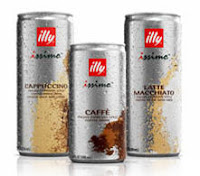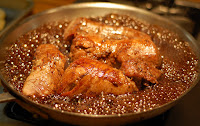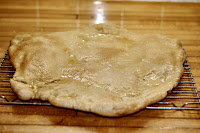Every year at Halloween, I set aside a day to make my signature spider web cookies. I use a handmade cookie cutter (I never could find one big enough for sale,) and my grandmother’s sugar cookie recipe. The trick is the icing technique. You make two batches of icing one plain white and one chocolate. After the cookies are cooled, put the chocolate icing in a pastry bag with a small round (I use a #2) tip. Spread white icing on one cookie to the edge with small spatula or the back of a teaspoon. Repeat with a second cookie, giving the first cookie time to set.
On the first cookie, using the chocolate icing in the pastry bag, pipe a spiral starting at the center and working outward. It helps to wipe the tip of the toothpick each time you drag the icing. Next, use the same dragging technique and position tip at the outside edge of the cookie, halfway between the outward spokes and drag icing inward to center to create another line. Repeat the dragging process with second iced cookie. Continue working in batches of 2 cookies.
When you have finished icing all the cookies, let them dry at room temperature. Add spiders when the icing has hardened. For the spider bodies you can make tiny chocolate cookies with the scraps of sugar cookie dough, or use M&Ms or nonpareils. Add eyes and legs using the chocolate icing.
Grammie’s Sugar CookiesUse flour on utensils to keep dough from sticking: Dip the cookie cutters, and dust the spatula before transferring uncooked dough to a sheet. Rolling dough between two sheets of floured parchment will keep it from sticking to the rolling pin. You can store cookies in airtight containers at room temperature, up to 1 week.
2 cups all-purpose flour, plus more for rolling
½ teaspoon baking powder
¼ teaspoon salt
½ cup (1 stick) unsalted butter, room temperature
1 cup granulated sugar
1 large egg
1 teaspoon vanilla extract
In large bowl, whisk flour, baking powder, and salt. With an electric mixer, cream butter and sugar until light and fluffy. Beat in egg and vanilla. With mixer on low, gradually add flour mixture; beat until combined. Divide dough in half; flatten into disks. Wrap each in plastic; freeze until firm, at least 20 minutes, or place in a resealable plastic bag, and freeze up to 3 months (thaw in refrigerator overnight).
Preheat oven to 325°F. Line baking sheets with parchment. Remove one dough disk; let stand 5 to 10 minutes. Roll out ¼ - ½ inch thick between two sheets of floured parchment, dusting dough with flour as needed. Cut shapes with cookie cutters. Using a spatula, transfer to prepared baking sheets. (If dough gets soft, chill 10 minutes.) Re-roll scraps; cut shapes. Repeat with remaining dough. Bake, rotating halfway through, until edges are golden, 10 to 18 minutes (depending on size). Cool completely on wire racks.
Royal IcingThis smooth, hard-drying icing is perfect for cookies. It is also useful as a "cement" to fasten decorations together like
gingerbread houses.
4 tablespoons Meringue Powder (or 2 egg whites plus 1 teaspoon lemon juice)
1 box (about 4 cups) confectioners' sugar
6 tablespoons warm water
You know you have the proper consistency when you lift the beater the ribbon of icing that falls back into the mixing bowl lays on the surface of the icing for a few seconds before disappearing. Because royal icing hardens when it is exposed to air, the icing needs to be used immediately or transferred to an airtight container. Cover icing with plastic wrap when not in use.
“Oh what a tangled web we weave, When first we practice to deceive.” ~Sir Walter Scott























